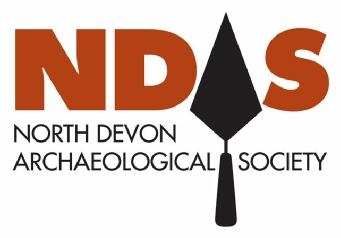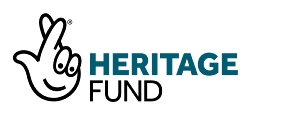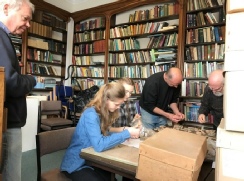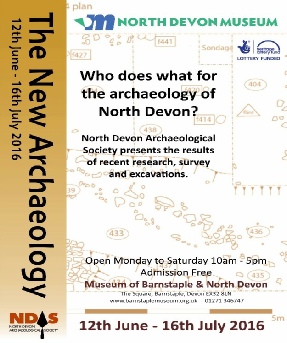Promoting awareness of the archaeology and history of North Devon

Copyright © 2015-
North Devon Archaeological Society wins Heritage Lottery Fund support for pottery project
North Devon Archaeological Society has received £15,200 from the Heritage Lottery
Fund (HLF) for an exciting project, ‘The Missing Link-
Work will start soon to analyse the several tons of pottery found on the site, which was next to the old Brannam Pottery. We aim to make the important discoveries accessible through publications, talks and public events, culminating in the national Festival of Archaeology in July this year.
North Devon has been an important centre of pottery manufacture since the 14th century,
and during the 17th century its distinctive 'Sgraffito' wares were exported to the
Americas. This assemblage represents the little-
Members of North Devon Archaeological Society are looking forward to working with the Museum of Barnstaple and North Devon, South West Archaeology and acknowledged experts from around the UK to deliver the project.
Linda Blanchard, Chair of North Devon Archaeological Society, said: ‘We are thrilled to have received the support of the Heritage Lottery Fund and our members are looking forward to finishing off the project we started 5 years ago.’
Nerys Watts, Head of Heritage Lottery Fund South West, said: ‘Thanks to National Lottery players, North Devon Archaeological Society has the chance to recover the “missing link” in its unique pottery history. This project will see regional archaeology groups working together to share valuable information and preserve Devon’s pottery history.’

North Devon Archaeological Society
The Missing Link: North Devon Pottery in the 16th Century
Heritage Lottery Our Heritage Evaluation Report
What did we do?
The Approved Purposes outlined in the original bid were as follows:
- The processing and quantification of the finds from the dig, producing specialist reports, with publication quality illustrations.
- Create an archive of the findings and undertake Radiocarbon dating to obtain scientific dates of the artefacts.
- Deliver a community engaging exhibition, with an accompanying written paper and leaflet, to be published in the Devon Archaeology Society magazine.
- Compile sample boxes of representative material from the dig for regional museums.
- Create a Pottery Trail leaflet for the general public. To be launched during the
Festival of British Archaeology.11-
26 July 2016.
How did it go?
The processing and quantification of the finds from the dig, producing specialist reports, with publication quality illustrations.
Five days of volunteer sessions were held in March and April 2016 to complete the quantification and select samples prior to specialist reports being produced. This involved 13 different volunteers working for a total of 11.4 days. Publication drawings of pottery, tile and kiln fabric were commissioned and produced. Specialist reports were written by John Allan, David Dawson and Imogen Wood, and collated by the Project Manager, Bryn Morris, into a final publication report, which will occupy 54 pages of the Transactions of the Devon Archaeological Society.
![]()

This part of the project went well, with good levels of interest from our volunteers, some of whom were new to the Society. However the work required by external experts did not proceed as quickly as expected. This was partly due to pressures of other work, and partly the recognition of significant material (kiln fabric) that required further analysis and comparison with other sites to make the published report as useful as possible.
The creation of illustrations was straightforward and accomplished quickly and professionally by South West Archaeology.
Create an archive of the findings and undertake Radiocarbon dating to obtain scientific dates of the artefacts.
All specialist reports have been received. The Radiocarbon date was obtained and
reported as 351 BP +/-
The archive has been prepared and details will be uploaded to OASIS when the final report has been peer reviewed. Paper archives and 62 boxes of finds will be lodged in the Museum of Barnstaple and North Devon. The museum has waived the box charge (which would have been £3100) in lieu of match funding.
Deliver a community engaging exhibition, with an accompanying written paper and leaflet, to be published in the Devon Archaeology Society magazine.

By Spring 2016 it became apparent that the specialist reports would not be complete in time for the exhibition programmed in June and July that year. The Society worked hard to create a community exhibition about the Exeter Inn but also incorporating materials from other community archaeology groups, results from recent developer funded investigation and information from Historic England and the County Archaeologists.
The exhibition ran from June 12th to July 16th and was seen by 5991 people. This included a visit from the Mediaeval Pottery Research Group who enjoyed a short talk about the Exeter Inn project and handled some of the finds.
The publication generated by the project will be printed in the 2017 volume of the transactions of the Devon Archaeological Society, to be printed in 2018. Attached is a letter confirming the publication, which has already been paid for. At 51MB this report is too large to be uploaded but can be provided on request.
A reduced version of the report has been produced by the Museum of Barnstaple & North Devon as a free booklet.
Compile sample boxes of representative material from the dig for regional museums.

An additional volunteer day was held on 9th March 2017 to recount and finalise samples for other museums. These have been packed and some were distributed at the recent Devonshire Association symposium on Newfoundland. The remainder will be distributed at the Devon Museums Group meeting on April 25th and a regional meeting on May 12th before we resort to mailing out any undelivered boxes.
Create a Pottery Trail leaflet for the general public. To be launched during the
Festival of British Archaeology.11-
Initial work on the pottery trail was done by volunteers from the Archaeological
Society and work experience students at the Museum and South West Archaeology. Final
design and printing was carried out by a professional designer. The trail booklet
was launched at a public meeting on March 21st, which also featured a talk about
the project to Society members and non-
Summary
The project has been a great success, enabling publication of this important excavation
and engaging Society members and members of the public in the detailed academic work
of bringing an excavation to public knowledge. We have satisfied the approved purposes,
although there have been changes to the timings. The project as a whole has taken
6 months longer than expected, largely due to delays in specialist reports being
created. This meant that we were unable to tie in the pottery trail leaflet with
the Festival of Archaeology in 2016. The lead-
Alison Mills
April 19th 2017
The full report will be found in the proceedings of the Devon Archaeology Society
issue 75 2017 pages 271-
